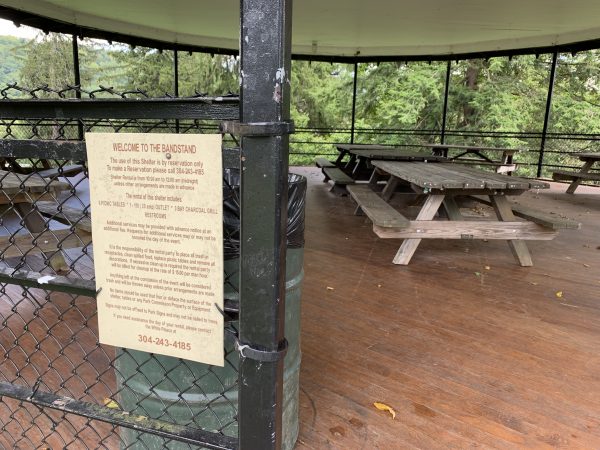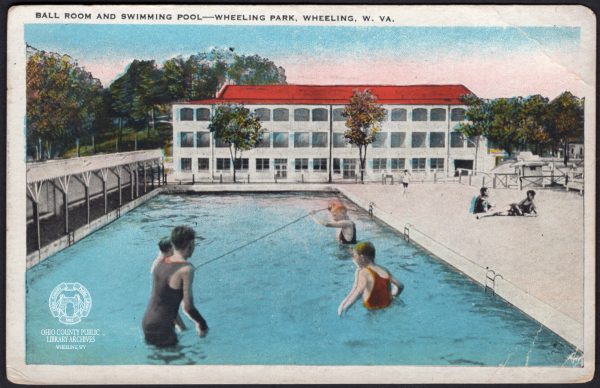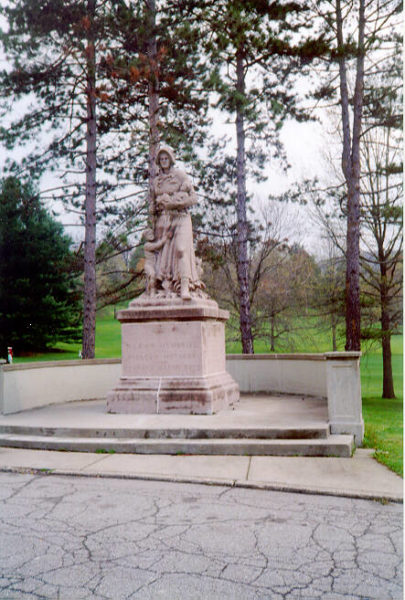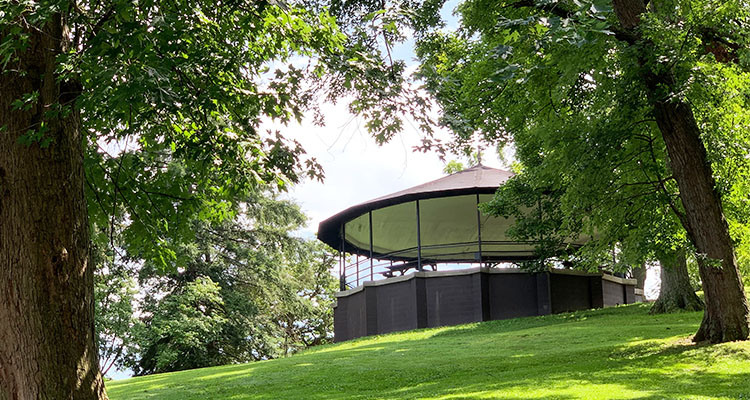It is in the middle of nowhere surrounded by lawn and tall trees but still in the middle of the park. Its remoteness was secured by its elevated perch high above the activity of the park.
 As I stood in the bandstand, I was transported back to when I was a youngster, before the pool existed at Oglebay. The big treat on Sundays, in summer, was after our treat of fresh cantaloupe for breakfast, my dad would take us to the pool at Wheeling Park. What a grand time, and the air was charged with excitement. We children were all ready, and I remember waiting impatiently for Dad in the car. The pool was always packed; one of the big draws was a sand “beach.” It seems as though we all got sunburned a little the first time out. And no matter how thoroughly we showered, sand always ended up in our beds.
As I stood in the bandstand, I was transported back to when I was a youngster, before the pool existed at Oglebay. The big treat on Sundays, in summer, was after our treat of fresh cantaloupe for breakfast, my dad would take us to the pool at Wheeling Park. What a grand time, and the air was charged with excitement. We children were all ready, and I remember waiting impatiently for Dad in the car. The pool was always packed; one of the big draws was a sand “beach.” It seems as though we all got sunburned a little the first time out. And no matter how thoroughly we showered, sand always ended up in our beds.
On the side overlooking the golf course, I could see and feel Momma’s house, the big Victorian across the Pike from Elmwood Place. It was a home that fascinated me as there was always something going on because it seemed as though it was always full of people. I didn’t realize that it was the middle of the Great Depression and three of Momma’s and Poppa’s adult children were living back home: Aunt Keka, aka Cornelia, single; Uncle Ralph and his wife, Lea, (he was a graduate civil engineer, a decorated artillery captain who almost lost a leg in WWI); and Aunt Elizabeth and her three youngsters (her husband Red was off in New York “seeking his fortune.”)
No one did bad stuff in those days to disgrace the family. ( My wife had an uncle who died of the “measles” in the early ’30s, which he caught years before in the Speakeasies of the roaring ’20s.)

Poppa was a quiet man who busied himself working in the basement filled with smells of bricks laid in the dirt floor, wood that was being worked, sawdust and circles of wood that had been shaved with a wood plane that had missed the sweep-up mixed with old paint cans and brushes. All was lighted by a single, naked bulb. To me, it was a magical place.
The center of operations was Momma’s kitchen. Her table where she made pies, and everything else was shiny with use. Wonderful meals and special treats like taffy to be pulled on Halloween and the weekly baking of doughnuts sprinkled with powdered sugar. A special treat for me, when I went with Mom on Saturday to pick up the bake goods for her big breakfast late Sunday morning, was getting to eat a hole out of a doughnut. Momma’s kugen or dutch cake topped with melted brown sugar was a special presentation at our Sunday breakfast (brunch).
Her daughters tried to capture her recipes by grabbing her hand to have her drop a pinch or a handful on to a wax paper to correctly measure. It didn’t work.
Halloween was a big event for all of us grandchildren. Poppa would fill a circular washtub with water and float an apple that we would bob for using just our mouths and no hands. I remember trying to capture an apple dangling from a string using only my teeth. The onlookers had great laughs at the futile attempts.
But the big event — besides running all through the big house — was pulling taffy. Momma would cook up a big pot and, when it had cooled, everyone received a handful of the sticky, dark brown concoction and pulled it over and over until it became light in color. Then we would have taffy candy. All the kids got some, and the house was pretty sticky when the evening was over.
We had a big family Thanksgiving dinner — I remember at Momma’s. The women had spent a great deal of time setting the table properly and decorating the dining room with colorful gourds and corn and leaves. We were all seated. Poppa said the blessing and awaited the star of the production, the turkey, which he would ceremoniously carve with great skill with appreciative comments from the assembled guests. Keka, being the youngest by far, was tasked with bringing the guest of honor to the table to be placed in front of Poppa. As she backed through the swinging door using her rump, the platter tipped, and the turkey slid off the platter on to the floor.
Momma didn’t drop a stitch as she said in a very calm and pleasant voice, “That’s all right Keka, dear, just take that one out and bring in the other turkey.” I didn’t figure out until later that there was no other turkey.
We usually would visit on Sundays in the late afternoon and sit on the front porch and watch for new cars to pass on National Road. It was very exciting when one did, and there would be discussion as to what make and model. I remember one time when Poppa was unusually talkative, and he described Indian — oops — Native American tribes at war with each other in the valley. He and his young buddies from the wagon train watched it from the top of a hill.
The 4th of July was a really big holiday when the clan would gather for a big picnic in the backyard. The women worked at preparing tons of food, which was served on a long table set up by Poppa of planks on saw-horses, which was beautifully done with tablecloths, etc. There would be upwards of 20 who would sit and talk, joke and eat. Poppa would drive two steel bars into the dirt and gravel driveway that ran alongside the house for the game of horseshoes. He would take the older grandchildren, which consisted of my two older sisters, for a walk to town over 29th Street. They returned by streetcar where they were dropped across the pike from the house. He then would take the rest of us who were old enough for a walk through the golf course at Wheeling Park to the White Palace or Pavillion where we were treated to our own nickel cup of ice cream with the wooden spoon. That was truly a very big deal.

There was a spring over the side of the hill toward Elm Grove with a natural stone basin. That is where we older boys were entrusted to carry the watermelons and place them in the spring water. The path to the spring was narrow, and the grownups trusted us more to navigate it carrying the melons.
The other chore we had was to take turns turning the crank in Poppa’s ice cream maker. His “1, 2, 3” — one part fresh lemon juice, two parts sugar (thoroughly mixed) and three parts milk — is really a great taste. One can make it in an ice cube tray.
Two indelible memories I have of those days 80-some years ago is Poppa’s garage with three big cars that had not been driven in years. I couldn’t understand why they didn’t use them instead of relying on Mom and others to take them to mass, shopping, etc. Of course, they had been wiped out in the market crash of 1929 and the subsequent depression.
The other is my dad walking me to the front of my grandparents’ house to National Road. He just wanted to move because it was very hot. As we turned to go back, he looked up at the third-floor windows where my Great Aunt Carrie lived. She always wore black and stayed pretty much to herself. He said, “Bill, there is the fifth argument for the existence of God.” I remember it well, although I never knew what he was talking about until I went to the university and studied Saint Thomas Aquinas — well, I was exposed to the subject. Anyway, Aunt Carrie was a very devout Catholic, and on her windowsill, there was a lighted vigil candle with lace curtains gently blowing back and forth around the flame.
The Madonna of the Trail statue, which commemorates the courage, improvising meals and, above all, that special maternal love that kept it all together, is located halfway between the entrance to Wheeling Park and Momma’s old Victorian. We were told that it was a statue of Momma, and I believed it for too many years.
Minetta Rener McFadden and Cornelius (“Connie”) A. McFadden, requiescat en pace.


